最新人教版七年级下册第九单元知识点
- 格式:doc
- 大小:22.00 KB
- 文档页数:3
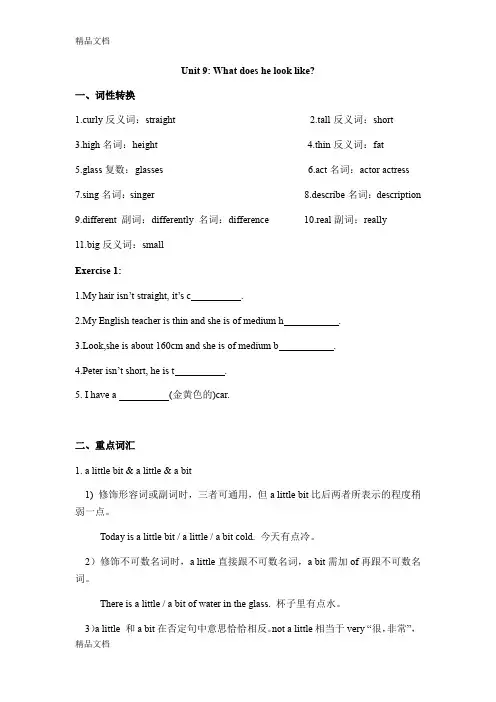
Unit 9: What does he look like?一、词性转换1.curly反义词:straight2.tall反义词:short3.high名词:height4.thin反义词:fat5.glass复数:glasses6.act名词:actor actress7.sing名词:singer 8.describe名词:description9.different 副词:differently 名词:difference 10.real副词:really11.big反义词:smallExercise 1:二、重点词汇1. a little bit & a little & a bit1) 修饰形容词或副词时,三者可通用,但a little bit比后两者所表示的程度稍弱一点。
Today is a little bit / a little / a bit cold. 今天有点冷。
2)修饰不可数名词时,a little直接跟不可数名词,a bit需加of再跟不可数名词。
There is a little / a bit of water in the glass. 杯子里有点水。
3)a little 和a bit在否定句中意思恰恰相反。
not a little相当于very “很,非常”,not a bit相当于not….at all“一点也不”。
① He is not a little hungry. = He is very hungry. 他很饿。
② He is not a bit hungry. = He isn’t hungry at all. 他一点也不饿。
2. stop to do sth. “停下来去做某事”。
指停止原来做的事情,去做另一件事情。
stop doing sth. “停止做某事”,指停止正在做的事情,即不做某事了。
E.g. He stops to do his homework.He stops doing his homework.Class begins, please stop talking.We are all tired, stop to have a rest.3. remember/forget doing sth. 记得/忘记做过某事(事情已做)remember/forget to do sth. 记得/忘记要去做某事(事情还没做)E.g. Please remember to eat lunch.I am sorry, I forget to my homework.I remember playing computer with my sister yesterday.I forget calling you.4. no more & not….any more & no longer & not….any longer1) no more = not….any more表示数量和程度的“不再(增加)”,常修饰终止性动词。
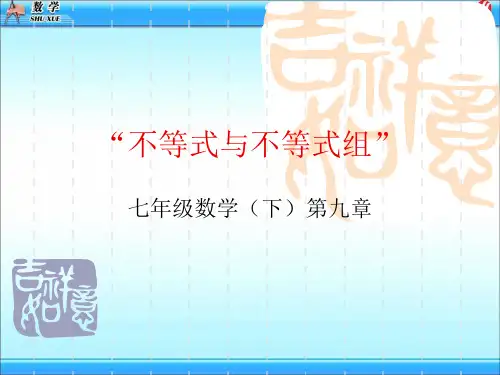
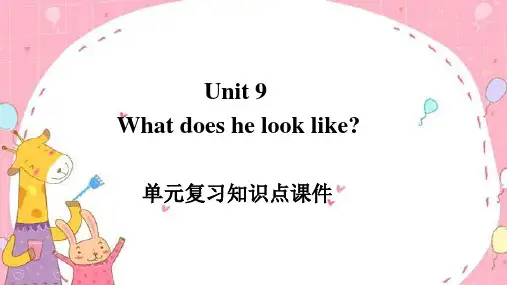
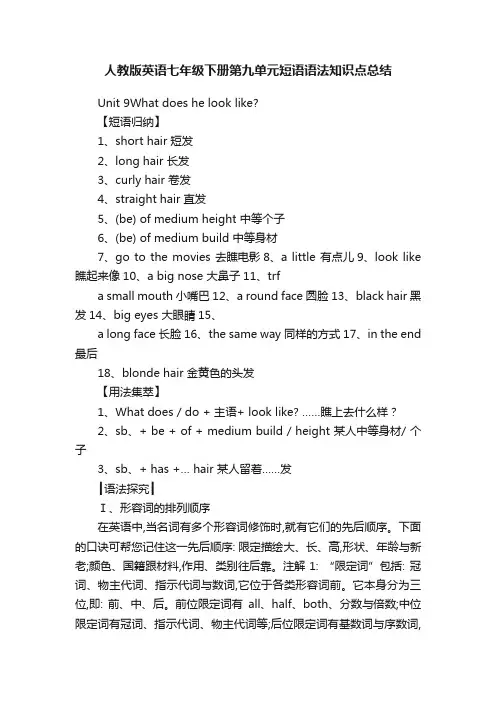
人教版英语七年级下册第九单元短语语法知识点总结Unit 9What does he look like?【短语归纳】1、short hair 短发2、long hair 长发3、curly hair 卷发4、straight hair 直发5、(be) of medium height 中等个子6、(be) of medium build 中等身材7、go to the movies 去瞧电影8、a little 有点儿9、look like 瞧起来像10、a big nose 大鼻子11、trfa small mouth 小嘴巴12、a round face 圆脸13、black hair 黑发14、big eyes 大眼睛15、a long face 长脸16、the same way 同样的方式17、in the end 最后18、blonde hair 金黄色的头发【用法集萃】1、What does / do + 主语+ look l ike? ……瞧上去什么样?2、sb、+ be + of + medium build / height 某人中等身材/ 个子3、sb、+ has +… hair 某人留着……发┃语法探究┃Ⅰ、形容词的排列顺序在英语中,当名词有多个形容词修饰时,就有它们的先后顺序。
下面的口诀可帮您记住这一先后顺序: 限定描绘大、长、高,形状、年龄与新老;颜色、国籍跟材料,作用、类别往后靠。
注解1: “限定词”包括: 冠词、物主代词、指示代词与数词,它位于各类形容词前。
它本身分为三位,即: 前、中、后。
前位限定词有all、half、both、分数与倍数;中位限定词有冠词、指示代词、物主代词等;后位限定词有基数词与序数词,但序数词位于基数词前。
如: both my hands; all his income、注解2: “描绘”性形容词。
如: beautiful、bad、cold、great等。
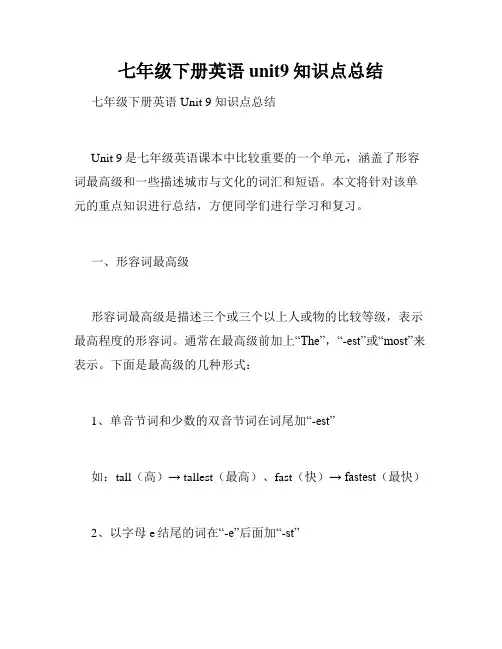
七年级下册英语unit9知识点总结七年级下册英语Unit 9 知识点总结Unit 9是七年级英语课本中比较重要的一个单元,涵盖了形容词最高级和一些描述城市与文化的词汇和短语。
本文将针对该单元的重点知识进行总结,方便同学们进行学习和复习。
一、形容词最高级形容词最高级是描述三个或三个以上人或物的比较等级,表示最高程度的形容词。
通常在最高级前加上“The”,“-est”或“most”来表示。
下面是最高级的几种形式:1、单音节词和少数的双音节词在词尾加“-est”如:tall(高)→ tallest(最高)、fast(快)→ fastest(最快)2、以字母e结尾的词在“-e”后面加“-st”如:large(大)→ largest(最大)3、以辅音字母+y结尾的词,变y为i,再加“-est”如:heavy(重)→ heaviest(最重)4、多音节词和少数双音节词在前面加上“most”如:beautiful(美丽)→ the most beautiful(最美丽),interesting(有趣的)→ the most interesting(最有趣的)二、词汇与短语1、城市地理与建筑①skyscraper(摩天大楼),如:The Empire State Building is a famous skyscraper in New York.②subway(地铁),如:The subway is a fast and convenient way to travel in the city.③bridge(桥),如:The Golden Gate Bridge is a famous bridge in San Francisco.2、城市交通①taxi(出租车),如:Taking a taxi is the quickest way to get to the airport.②bus(公共汽车),如:The bus is a popular mode of transportation in big cities.③bicycle(自行车),如:Riding a bicycle is a great way to stay healthy and help the environment.3、文化和艺术①museum(博物馆),如:The Louvre Museum in Paris is famous for its collection of art and artifacts.②exhibition(展览),如:There is an excellent exhibition of modern art at the museum.③opera(歌剧),如:The Metropolitan Opera House in New York is famous for its productions of operas.三、实用句型和表达方式1、询问方向①Excuse me, can you tell me the way to…?②How do I get to…?③Is it far from here?2、描述城市①The city is full of tall buildings and bustling streets.②The parks in the city are great places to relax and enjoy nature.③The city has a rich history and many cultural treasures to explore.以上就是Unit 9的主要知识点。
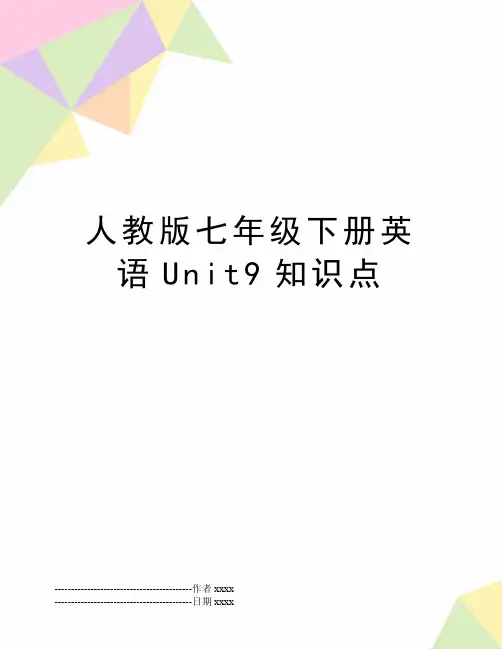
人教版七年级下册英语U n i t9知识点------------------------------------------作者xxxx------------------------------------------日期xxxxUnit9 名词:height 身高;高度cinema 电影院glasses 眼镜actor 演员actress女演员person 人nose 鼻子mouth 嘴face 脸eye眼睛singer 歌手artist 艺术家way方式;路线end 结尾;尽头动词:may 也许;可能;可以put 放describe 描述形容词:straight 直的curly 卷曲的tall高的thin 瘦的heavy 重的little 小的medium 中等的handsome英俊的round 圆形的real 真正的;真实的副词:later 以后differently 不同地兼类词:tonight adv&n(在)今晚;(在)今夜each adj&pron 每个;各自another adj&pron另一;又一短语:(be)of medium height 中等身高a little 一点;少量look like 看起来像first of all 首先in the end最后知识点:1、tall 高的反义词 short矮的,常指人、动物、树、建筑物等很高a tall tree一棵高高的树a tall building 一栋高楼high 高的反义词low 低的,多指山高,也指空间位置或程度高,还可以指价格、速度、温度等a high mountain一座高山high price 价格高2、medium 中等的be of medium height 中等身高be of medium build 中等身材My uncle is of medium height。
我叔叔中等身高.区分:middle 中间的;中部的There is a tree in themiddle of hisyard. 他的院子中央有一棵树。
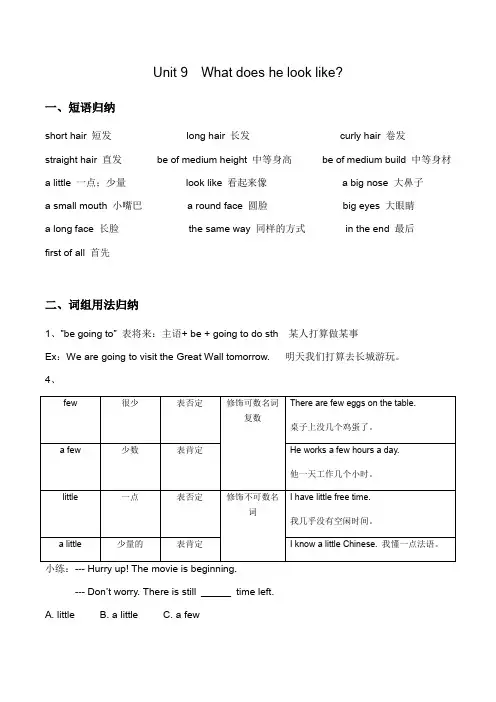
Unit 9 What does he look like?一、短语归纳short hair 短发long hair 长发curly hair 卷发straight hair 直发be of medium height 中等身高be of medium build 中等身材a little 一点;少量look like 看起来像 a big nose 大鼻子a small mouth 小嘴巴 a round face 圆脸big eyes 大眼睛a long face 长脸the same way 同样的方式in the end 最后first of all 首先二、词组用法归纳1、”be going to” 表将来:主语+ be + going to do sth 某人打算做某事Ex:We are going to visit the Great Wall tomorrow. 明天我们打算去长城游玩。
4、小练:--- Hurry up! The movie is beginning.--- Don’t worry. There is still time left.A. littleB. a littleC. a few5、each:做形容词时,修饰可数名词单数,意为“每个;各自”Ex:Each school has its own library. 每一所学校都有它自己的图书馆。
三、语法归纳(一)询问及描述外貌:1、询问外貌:What do/ does sb look like? 某人长什么样?2、描述人的外貌的句型如下:(1)表示某人的个头或身材:主语+ be of +形容词+ height/ build.Ex:Our math teacher is of medium build. 我们的数学老师是中等身材。
(2)表示某人的高矮胖瘦:主语+be +形容词.Ex:She is short and thin. 她很瘦小。
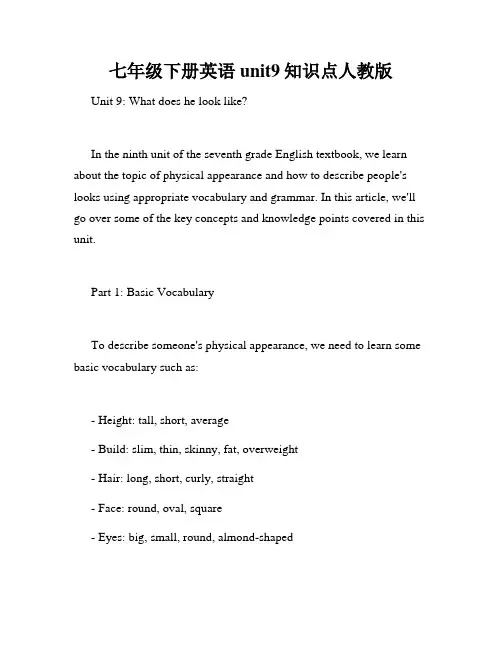
七年级下册英语unit9知识点人教版Unit 9: What does he look like?In the ninth unit of the seventh grade English textbook, we learn about the topic of physical appearance and how to describe people's looks using appropriate vocabulary and grammar. In this article, we'll go over some of the key concepts and knowledge points covered in this unit.Part 1: Basic VocabularyTo describe someone's physical appearance, we need to learn some basic vocabulary such as:- Height: tall, short, average- Build: slim, thin, skinny, fat, overweight- Hair: long, short, curly, straight- Face: round, oval, square- Eyes: big, small, round, almond-shapedPart 2: Describing PeopleWhen describing someone's physical appearance, we often use adjectives that indicate the person's characteristics. For example:- He is tall and slim with short curly hair and big round eyes.- She is short and overweight with long straight hair and small almond-shaped eyes.We can also use comparative and superlative forms of adjectives to compare two or more people's physical appearance. For example:- Peter is taller than Tom, but Tom is thinner than Peter.- Among the three sisters, Lucy is the shortest, but she has the longest hair.Part 3: Asking and Answering QuestionsIn Unit 9, we also learn how to ask and answer questions about someone's physical appearance. For example:Q: What does your father look like?A: He is tall and slim with short straight hair and small round eyes.Q: How tall are you?A: I'm an average height for my age.Part 4: Reading ComprehensionIn this unit, we also practice reading comprehension skills by reading passages about people's physical appearance and answering questions based on the information provided. This helps us develop our ability to scan and skim texts, as well as understand the main idea and supporting details of a piece of writing.Part 5: Listening and SpeakingIn addition to reading and writing, Unit 9 also includes listening and speaking activities that allow us to practice our communication skills. For example, we listen to descriptions of people and try to draw their portraits based on the information given. We also work in pairs or small groups to describe each other's physical appearance and try to guess who the other person is.ConclusionIn conclusion, Unit 9 of the seventh grade English textbook is all about physical appearance and how to describe people's looks using vocabulary, grammar, and communication skills. By mastering the knowledge points covered in this unit, we can better communicate with others and express ourselves more accurately and effectively.。
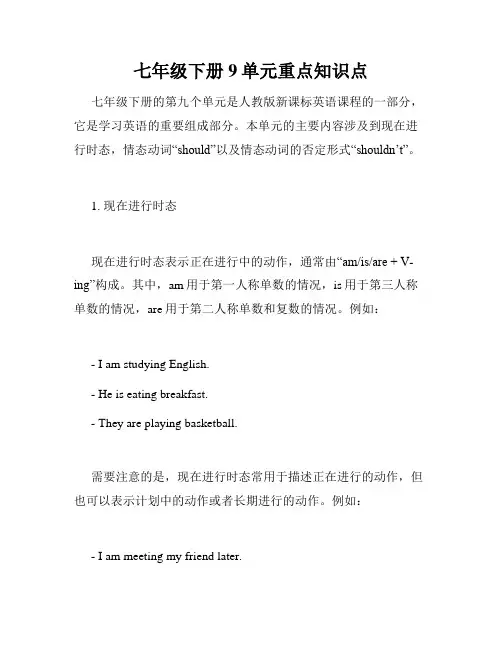
七年级下册9单元重点知识点七年级下册的第九个单元是人教版新课标英语课程的一部分,它是学习英语的重要组成部分。
本单元的主要内容涉及到现在进行时态,情态动词“should”以及情态动词的否定形式“shouldn’t”。
1. 现在进行时态现在进行时态表示正在进行中的动作,通常由“am/is/are + V-ing”构成。
其中,am用于第一人称单数的情况,is用于第三人称单数的情况,are用于第二人称单数和复数的情况。
例如:- I am studying English.- He is eating breakfast.- They are playing basketball.需要注意的是,现在进行时态常用于描述正在进行的动作,但也可以表示计划中的动作或者长期进行的动作。
例如:- I am meeting my friend later.- She is always talking about her job.2. 情态动词“should”情态动词“should”表示“应该”,通常用于建议、责任、义务、推荐等语境中,后接动词原形。
例如:- You should drink more water.- We should recycle more materials to protect the environment.需要注意的是,情态动词“should”不仅用于对自己的建议、责任、义务、推荐等语境中,也可用于对别人的建议、责任、义务、推荐等语境中。
例如:- You should tell your teacher about your problem.- She should take a break and relax.3. 情态动词的否定形式“shouldn’t”情态动词的否定形式“shouldn’t”表示“不应该”,用于表示反对或禁止某事物的发生。
构成方式为“shouldn’t+动词原形”。
例如:- You shouldn’t eat too much junk food.- We shouldn’t waste water.需要注意的是,情态动词的否定形式“shouldn’t”同样可用于对自己以外的人或者事物的反对或者禁止语境中。

Unit 9 What does he look like?1.重点词汇:straight, tall, thin, heavy, round, handsome, face, mouth, eye, nose, glasses, actor, actress, put, describe2.短语归纳:1. short hair 短发2. long hair 长发3. curly hair 卷发4. straight hair 直发5. (be) of medium height 中等个子6. (be) of medium build 中等身材7. go to the movies 去看电影8. a little 有点儿9. look like 看起来像10. a big nose 大鼻子11. a small mouth 小嘴巴12. a round face 圆脸13. black hair 黑发14. big eyes 大眼睛3. 必背典句:1. —What does he look like? 他长什么样?—He’s really tall. 他真的很高。
2. —Do they have straight or curly hair? 他们留直发还是卷发?—They have curly hair. 他们留卷发。
3. —Is he tall or short? 他高还是矮?—He isn’t tall or short. He’s of medium height. 他不高不矮,他中等个子。
4.The man with a pair of glasses is my English teacher. 那个戴眼镜的男人是我的英语老师。
4.语法知识:like的用法:1. like表喜欢2. be like表相像3. look like 看起来像some和any在“there be”句型中的用法:some 一些(some用于肯定句)any 一些(any用于否定句和一般疑问句)注意:在希望得到对方肯定回答的疑问句中要用some。
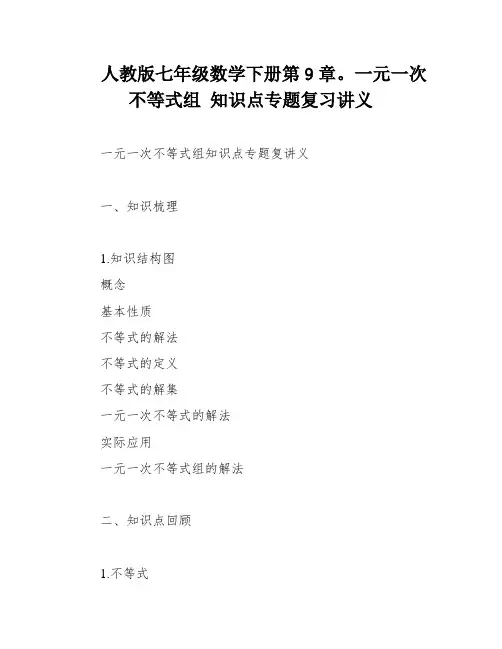
人教版七年级数学下册第9章。
一元一次不等式组知识点专题复习讲义一元一次不等式组知识点专题复讲义一、知识梳理1.知识结构图概念基本性质不等式的解法不等式的定义不等式的解集一元一次不等式的解法实际应用一元一次不等式组的解法二、知识点回顾1.不等式不等式是由不等号连接起来的式子。
常见的不等号有五种:“≠”、“>”、“<”、“≥”、“≤”。
2.不等式的解与解集不等式的解是使不等式成立的未知数的值。
不等式的解集是一个含有未知数的不等式的解的全体。
解集可以在数轴上直观的表示出来,具体表示方法是先确定边界点。
解集包含边界点,是实心圆点;不包含边界点,则是空心圆圈;再确定方向:大向右,小向左。
3.不等式的基本性质1) 不等式的两边都加上(或减去)同一个数或同一个整式,不等号的方向不变。
2) 不等式的两边都乘以(或除以)同一个正数,不等号的方向不变。
3) 不等式的两边都乘以(或除以)同一个负数,不等号的方向改变。
4.一元一次不等式一元一次不等式只含有一个未知数,且未知数的次数是1.系数不等于的不等式叫做一元一次不等式。
其标准形式为:ax+b<或ax+b≤,ax+b>或ax+b≥0(a≠0)。
5.解一元一次不等式的一般步骤1) 去分母;2) 去括号;3) 移项;4) 合并同类项;5) 化系数为1.删除格式错误的段落。
对于每段话,进行小幅度的改写,使其更加通顺易懂。
解一元一次不等式和解一元一次方程类似。
不同的是,一元一次不等式两边同乘以(或除以)同一个负数时,不等号的方向必须改变。
这是解不等式时最容易出错的地方。
例如,解不等式:-2/3x-1≤1/3解:去分母,得(3x-1)-2(3x-1)≤2(不要漏乘!每一项都得乘)去括号,得3x-3-6x+2≤2(注意符号,不要漏乘!)移项,得3x-6x≤2+3-1(移项要变号)合并同类项,得-3x≤4(计算要正确)系数化为1,得x≥-4/3(同除负,不等号方向要改变,分子分母别颠倒了)一元一次不等式组是含有相同未知数的几个一元一次不等式所组成的不等式组。
人教版丨七年级下册英语9单元知识点总结Unit 9单词(音标)curly ['kɜː(r)li] adj. 卷曲的straight [streɪt] adj.直的tall [tɔːl] adj. 高的medium ['miːdɪəm] adj.中等的height [haɪt] n.身高;高度(be) of medium height中等身高thin [θɪn] adj.瘦的heavy ['hevi] adj. 重的build [bɪld] v.身材(be) of medium build 中等身材tonight [tə'naɪt] adv.&n.(在)今晚;(在)今夜little ['lɪtl] adj. 小的a little一点儿,少量cinema ['sɪnɪmə] n.电影院glasses ['glɑ:sɪz](pl.)n. [轻] 眼镜later ['leɪtə(r)] adv.以后handsome ['hænsəm] adj.英俊的actor ['æktə(r)] n.演员actress ['æktrəs] n. 女演员person ['pɜː(r)sn] n. 人nose [nəʊz] n. 鼻子blonde [blɒnd] adj.(头发)金黄色的mouth [maʊθ] n.嘴round [raʊnd] adj. 圆形的face [feɪs] n. 脸eye [aɪ] n. 眼睛singer ['sɪŋə(r)] n. 歌手artist ['ɑː(r)tɪst] n. 艺术家crime [kraɪm] n.犯罪活动criminal ['krɪmɪnl] n. 罪犯put [pʊt] v. 放each [iːtʃ] adj. &pron. 每个;各自way [weɪ] n.方式;路线describe [dɪ'skraɪb] v.描述differently ['dɪfərəntli] adv. 不同地another [ə'nʌðə(r)] adj.&pron. 另一;又一end [end] n. 结尾;尽头in the end最后real [rɪəl] adj.真正的;真实的jeans [dʒi:nz] n. 牛仔裤Johnny ['dʒɒni]约翰尼(男名)Dean [di:n]迪安(姓)Tina ['ti:nə]蒂娜(女名)Jackson ['dʒæksən] 杰克逊(姓)Unit9 知识梳理【重点短语】1. look like 看起来像2. short/long/curly/straighthair短/长/卷/直发2. medium height 中等身高3. medium build 中等身材4. be a little late 有点儿晚5. wear glasses 戴眼镜6. See you later then. 那么回头见。
人教版七年级下册英语9单元知识点总结人教版七年级下册英语9单元知识点总结一、词汇拓展(1)act v.表演;行动n.行动;所做之事→action n.行为;动作→actor n.演员→actress n.女演员(2)art n.艺术→artist n.艺术家;画家(3)person n.人;人物→personal adj.个人的(4)sing v.唱;唱歌→singer n.歌唱家;歌手(5)end n.结尾;尽头v.结束→endless adj.无止境的;没完没了的→ending n.结局;结尾(6)high adj.高的→height n.高度(7)different adj.不同的;有区别的→difference n.区别;不同之处→differently adv.不同地(8)real adj.真的;真实的→really adv.真实地;真正地二、短语归纳1.Short \curly\long \straight \blonde \black\ white hair2.be of medium build\ height 中等身材、身高3.look like看起来像4.draw a picture of......画一幅......的画5. a little late有点儿迟6. a little = a little bit = a bit =kind of 有点……(后接形容词或副词)7. a little milk = a bit of milk少许牛奶8.meet sb接某人、与某人见面9.have a meeting 开会10.have a sports meeting 举行运动会11.in front of在……前面12.go to the cinema= go to the movies= see movies(去)看电影13.wear glasses= have glasses 戴眼镜14.a pair of glasses 一副眼镜15.be like 像...一样16.have blonde hair= wear blonde hair留着金黄色的头发17.a very interesting job一个非常有趣的工作18.a police artist警察艺术家19.talk to sb对某人说话20.look the same 看起来一样21.in the end = at last =finally最后,终于22.first of all首先23.sports shoes运动鞋24.be good at 擅长于25.like to do喜欢做26.remember doing sth 记得做过了某事27.remember to do sth记得要做某事28.stop doing sth停止做某事29.stop to do sth停下来去做某事30.be different from…与……不同三、知识点build(1)build作名词意为“体格,体型”例如:a man of strong build(2)build 作动词意为“建造,建设,建立”→building n.建筑物例如:We are building a house.四、知识点 a little bit , a bit&a little表示“有点,一点”时,三者可以通用。
Unit 9 How was your weekend?一、词组1.do one’s homework=do homework 做某人的家庭作业(do my homework 做我的家庭作业)2.play +运动或棋类(如:play soccer 踢足球play chess 下棋)3.play +the+乐器(如:play the guitar 弹吉他)4.clean my room 打扫我的房间5.go to the beach 去海滩6.go to the movies 去看电影7. on Saturday morning周六上午(in the morning/afternoon/evening 在早上/在下午/在晚上)[介词(prep): ① on + 具体的星期几/ 日期Eg: on Sundays/ July 7② in + 月/年/季节/世纪Eg; in July/ 2006/ summer/ 21century③ at + 具体钟点Eg; at 7:00]8. visit sb 拜访某人(visit my friend 看望我的朋友)9. study for the (math) test 准备(数学)考试10. do some reading 阅读(do+some+ving表示动作)[do some washing洗衣服do some cooking做饭do some shopping购物]11. stay at home 呆在家里12. have a party 举行一个晚会13. practice English 练习英语[practice (practiced) doing sth 练习做某事(类似用法:like, enjoy, have fun)]14.study geography 学习地理15. go shopping 去购物(go+v.ing 表示“去做某事”)[go swimming去游泳go boating去划船go climbing 去爬山]16. play computer games 玩电脑游戏17. go to summer camp 去夏令营18. go to the mountains 去爬山19. go for a walk 散步20.read a book about history 读一本历史书21.see an interesting talk show 看一个有趣的访谈节目22.write a new song 写一首新歌23. spend the weekend 度假[spend (spent) sometime / money (in) doing sth花费时间/金钱做某事spend (spent) sometime / money on sth 在某事上花费时间/金钱做某事]24. look for 寻找(的动作)find (found) 寻找(的结果)[Eg: I looked for everywhere but I couldn’t find my key.我找了所有的地方,都没有找到我的钥匙。
初中英语人教版七年级下册Unit9知识点总结Unit 9是初中英语人教版七年级下册中的一单元,主要教授有关旅游的词汇与知识。
本单元内容十分丰富,除了介绍一些旅游的背景知识外,还包括了动词的时态、表示月份和日期的语法等等。
下面,我们来总结一下本单元的重点知识。
1. 旅游相关的单词和短语本单元的重点之一在于介绍了一些和旅游有关的单词和短语,如travel、journey、destination、sightseeing等等。
在进行旅游计划和描述旅游经历时,这些单词和短语会非常常用,我们需要对它们有充分的掌握。
2. 表示目的地的介词在进行旅游计划时,我们需要使用到一些表示目的地的介词,如to、in等等。
需要注意的是,介词的使用方式和用法都是非常的灵活多样的。
我们需要根据不同的语境和需要,正确选择合适的介词。
3. 动词的时态在本单元中,我们学习了一些动词的时态,如一般现在时、一般过去时等等。
这些时态的使用非常广泛,尤其是在进行日常交流和描述事物时,非常重要。
4. 时间和日期的表达在进行旅游计划和描述旅游经历时,我们还需要涉及到时间和日期的表达。
本单元中,我们学习了如何表示月份、星期几、具体日期等等。
这些知识点对于描述旅游计划和旅游经历非常实用。
5. 特殊疑问句的构造在进行交流时,我们有时需要使用特殊疑问句来询问某些具体信息。
本单元中,我们学习了如何构造特殊疑问句,如何使用特殊疑问词来引导疑问的构成等等。
这些知识点对于提高我们的口语表达能力非常有帮助。
6. 一些其他的语法除了以上几个重点知识点外,本单元还包括了一些其他的语法知识,如动词的不定式、形容词的比较级和最高级等等。
这些语法知识虽然不是本单元的核心内容,但是对于语言学习的全面性和深度也非常重要。
总之,本单元的知识点非常丰富,而且涵盖面也非常广泛。
我们在学习的过程中,需要充分认识到这些知识的重要性,注重对于基础知识的掌握和实际应用能力的提高。
人教版七年级英语下册第九单元知识点归纳Unit 9 What does he look like?◆短语归纳1. short hair 短发2. long hair 长发3. curly hair 卷发4. straight hair 直发5. (be) of medium height 中等个子6. (be) of medium build 中等身材7. go to the movies 去看电影 8. a little有点儿9. look like 看起来像10. a big nose 大鼻子11. a small mouth 小嘴巴12. a round face 圆脸13. black hair 黑发14. big eyes 大眼睛15. a long face 长脸16. the same way 同样的方式17. in the end 最后18. blonde hair 金黄色的头发19 a little bit =a little=kind of 一点儿… 20. a pop singer 一位流行歌手21. have a new look 呈现新面貌21. go shopping (do some shopping) 去购物21. the captain of the basketball team 篮球队队长22.one of --- ---中的一个23. be popular with sb 受某人欢迎24. stop to do sth 停下来去做某事25. stop doing sth 停止正在做的事情26. tell jokes/stories 讲笑话/ 讲故事27. have fun doing sth 愉快地做某事28. remember ( forget) to do sth 记得(忘记)做某事(没有做的)29. remember (forget) doing sth 记得(忘记)做过某事(已做)30.be +高矮胖瘦31.what do/does look like?=what +be +sb.+like?询问某人的外貌◆用法集萃1. What does / do + 主语+ look like? ……长得什么样?2. sb. + be + of + medium build / height 某人中等身材/个子3. sb. + has +… hair 某人留着……发4. sb. wears + clothes/glasses 某人穿着/戴着……◆典句必背1. —What does he look like? 他长什么样—He’s really tall. 他真的很高。
1. What does he look like?他什么?【解析 1】 look like意“看起来像” ,用来某人的身材或相,即外貌,其构:“ What+ do/does +主+ look like?”【解析 2】be like 像⋯⋯一,指品德、相貌等像(指人的个性特征)如果人的性格、人品,多用What be(am/is/are)⋯like?— What’ s he like?他是个什么的人呢?— He’ s friendly and kind. 他友好善良。
【拓展】回答相貌的提:a)— What do/does sb. look like?— sb. +be+形容 /— What does she look like?— She is tall.b)— What do/does sb. look like?— sb. be of +名(指描述某人的体形、身材等)—What does she look like?—She is of medium build.c)have/has +形容 +名(指某人的体貌特征)—What does she look like?—She has long hair() 1. I ____ my mother and I ______ her.A. am like; likeB. am like; am likeC. like; likeD. like; am likes() 2. - How do you _______ China?-Very much.A. likeB. likesC. likedD. look like2.She is of medium build, and she has long straight hair.她身材适中,留着。
【解析 1】 medium build中等身材1)build 作名意“体格,体型”。
有两种表达方法:He is of medium build. = He has a medium build.2)build 作意“建造,建,建立”。
1. What does he look like? 他长什么样?
【解析1】look like 意为“看起来像”,用来询问某人的身材或长相,即外貌,其结构为:“What +do/does +主语+look like?”
【解析2】be like 像……一样,指品德、相貌等像(指人的个性特征)
如果询问人的性格、人品时,多用What be(am/is/are)…like?
—What’s he like? 他是个什么样的人呢?
—He’s friendly and kind. 他友好善良。
【拓展】回答相貌的提问:
a) —What do/does sb. look like?
—sb. +be+形容词/
—What does she look like?
—She is tall.
b) —What do/does sb. look like?
—sb. be of +名词(指描述某人的体形、身材等)
—What does she look like?
—She is of medium build.
c) have/has +形容词+名词(指强调某人的体貌特征)
—What does she look like?
—She has long hair
( ) 1. I ____ my mother and I ______ her.
A. am like; like
B. am like; am like
C. like; like
D. like; am likes
( ) 2. -How do you _______ China?
-Very much.
A. like
B. likes
C. liked
D. look like
2.She is of medium build, and she has long straight hair. 她身材适中,留着长发。
【解析1】medium build 中等身材
1) build作名词意为“体格,体型”。
有两种表达方法:
He is of medium build. = He has a medium build.
2) build 作动词意为“建造,建设,建立”。
例如:
We are building a house. 我们正在建造一个房子。
【解析2】表示某人中等身材或中等个头时,其构成为:
“sb +be +of +medium build/height”。
She is of medium height. 她中等的身高。
【解析3】表示“某人长着或留着发”时,则只能用has/have, 其构成为:
“主语+have/has +…hair”。
He has short hair. 他有短发。
注:“be +形容词”强调某人是……样子的外形,常用于描述大概的体形、身高等。
“have/has +名词”结构强调某人具有的相貌特征,常用于描述五官、相貌等。
)( ) 1. Our captain _______ tall and he _______ a medium build.
A. has; has
B. has; is
C. is; has
D. is; is
( ) 2. My sister ____ curly hair and she ____ of medium height.
A. is, is
B. has; has
C. has; is
D.is; has
3. We’re meeting at seven, right?我们今晚七点见面,是吗?
现在进行时表将来表示按计划、安排将要发生的动作,常跟tomorrow, soon等表示将来的时间状语。
能用这种结构表示将来的动词往往是表示位移动词,如:
go, come, leave, arrive, start, begin, move, fly等
They are going to the village tomorrow.
My brother are coming to my home soon.
4.Yes , but I may be a little late. 是的,但我或许要晚点。
【解析1】a little, a bit, a little bit, a bit of
1) a little = a bit = a little bit 表示“有点”,后接形容词或副词。
It's a little hot today. 今天有点热。
2) a little = a bit of 表示肯定,意为“有一点”,后接不可数名词。
There is a little rain tomorrow. 明天有小雨。
拓展:little意为“几乎没有”,表示否定的含义。
There is little rain here in spring, so it's very dry. 春天几乎没下过雨,所以很干燥。
5.Well, he has brown hair and wears glasses. 他留着棕色的头发,戴眼镜。
【解析1】wear, put on, have on都表示“穿”,用法区别如下:
1) wear有“穿着;戴着”的意思,强调状态。
常用一般现在时表示经常状态,用进行时态表示暂时状态。
wear还可用来表示佩戴手表、首饰、徽章等以及留头发,胡须等。
2) put on有“穿上;戴上”,强调动作,是终止性动词短语,不能跟表示一段时间的状语连用。
3) dress的宾语通常是人,意思是“给……穿衣服”。
dress oneself 意为“给自己穿衣服”。
get dressed意为“穿好衣服”。
( ) 1. He always ______ black trousers and he always ______ his son in black.
A. dress; dress
B. wears; puts on
C. wears; dresses
D. puts on; wears
( ) 2. He likes _______ the red coat.
A. wearing
B. wears
C. putting on
D. dressing
【解析2】glass的用法
1) glass作“玻璃”讲时,为不可数名词。
Glass breaks easily. 玻璃易碎。
2) glass作“玻璃杯”讲时,为可数名词。
Please have a glass of water. 请喝杯水。
He handed the glasses of beer to his father. 他把那几杯啤酒递给了父亲。
3) glass作“眼镜”讲时,只用复数形式。
a pair of glasses 一副眼镜
He’s wearing a pair of glasses. 他戴着一副眼镜。
( ) I like wearing _______ in hot summer.
A. a glass
B. glass
C. some glasses
D. glasses
6. He has long straight brown hair. 他有着长长的棕色直发。
【解析】几个形容词修饰一个名词时的顺序:长短→形状→颜色。
She has short curly blonde hair.
7. He wants to draw a good picture of each criminal. 他想尽可能画出每一个罪犯的肖像画。
1) each做副词,意为“每一个”。
For boys, you can buy shirts for only 30 yuan each.
2) each做形容词,修饰名词时,名词要用可数名词单数形式。
Each boy has a pair of socks.
3)each做代词,可与of连用;做主语时,谓动词用单数。
Each of the boys has a pair of socks.。